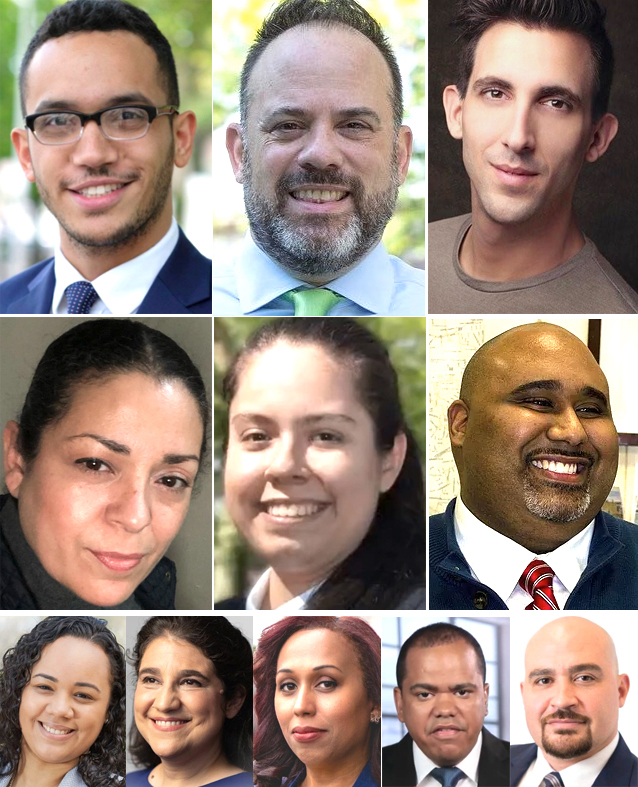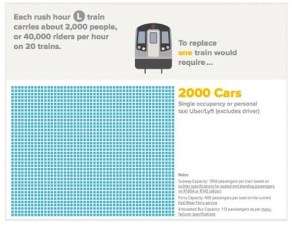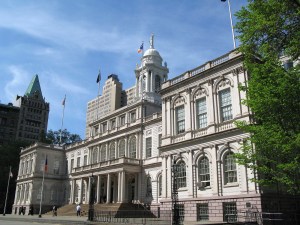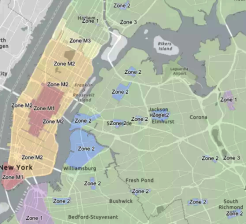DECISION 2021: A Preview of Two Manhattan Uptown Council Districts
Districts 7 and 10 have lively races with several street-savvy candidates.

City Council districts 7 and 10, in Manhattan above 96th Street on the West Side have much in common.
Both have many candidates vying in the June 22 Democratic Primary to replace the term-limited incumbents.
Both districts are well served by transit, with many buses up their broad avenues and the IRT and IND subways running up their spines. Accessibility for disabled New Yorkers is an issue for both train lines, although the IRT’s No. 1 line is the worst; between 72nd and 231st Streets, there is only one station — 96th Street — that has both uptown and downtown elevators.
In both races, most candidates take fairly similar, progressive views on street-safety issues (as much else): For example, almost all say they would like to expand open streets, bus lanes and protected bike lanes and support an all-electric bus fleet — with varying enthusiasm. With little to distinguish them ideologically, the differences mainly run to how much weight they would give to local interests that complain about such city initiatives, such as private car drivers, taxi drivers and some businesses. Winning the Democratic primary is tantamount to winning in November.
So what do you need to know?
District 7

District 7 — currently served by term-limited Council Member Mark Levine and encompassing Manhattan Valley, Manhattanville, Morningside Heights, and Hamilton Heights — has a 13-candidate race, with nine having garnered enough contributions to pick up city matching funds, a sign that they are competitive. They are:
- Shaun Abreu, a tenants’-rights attorney
- Marti Allen-Cummings, an activist, gig worker and drag artist
- Daniel Cohen, an affordable-housing advocate
- Miguel Estrella, information unavailable
- Keith Harris, a communications engineer
- Stacy Lynch, a lawyer and community activist
- Lena Melendez, a housing activist
- Maria Ordonez, a tenants’ rights organizer
- Corey Ortega, a community organizer and Council staffer
- Carmen Quinones, a Democratic district leader
- Ray Sanchez, general counsel for Bronx Borough President Ruben Diaz
- Luis Tejada, a tenants’ rights organizer
- Jomo Williams, information unavailable
District 7 has a Goliath of a local institution and employer — Columbia University and its affiliates, whose campuses stretch along Broadway and Amsterdam avenues from 116th to 135th streets. It is plagued by drivers, many from out of state, who park there either pursuant to their university jobs or to take transit into the Central Business District; thus, most candidates favor piloting a program of residential parking permits to protect local residents’ “right” to curb spaces — although such programs are controversial.
Several also favor bringing other forms of transit to less accessible waterfront areas of the district, via a proposed Amtrak station at 125th Street and Twelfth Avenue or bringing the NYC Ferry north along the Hudson.
And safety is an issue in the district: In 2019, the last full year with reliable stats, there were 2,297 total reported crashes, causing 511 injuries (72 cyclists, 134 pedestrians and 305 motorists) and four deaths (three pedestrians and one motorists). That’s more than six crashes per day.
The following quotes were culled from interviews with Streetsblog or from the May 11 Transportation Alternatives online forum.
The highly activist field dominated by housing advocates has a lively feel for street safety, in part because of the fervent advocacy of one colorful and voluble candidate: Marti Allen-Cummings.
“During the pandemic, we saw that buses were so crucial,” Allen-Cummings told Streetsblog. “We need to expand busways and protected bike lanes so that delivery workers don’t get injured or hurt doing their jobs. It will also help with our carbon footprint.”
Allen-Cummings calls alternative transportation “part of my personal belief system” and says that “access to transportation is intersectional with the racial, environmental and economic justice we need.”
Allen-Cummings’ activist, boosterish personality has led to a lead among private, small-dollar donors.

Allen-Cummings is not the only candidate vying for the mantle of most street savvy, however. Cohen has sought to brand himself as such, by citing on his website the 2021 Transportation Equity Agenda “put forward by organizations like StreetsPAC, Riders Alliance, and Transportation Alternatives — as a basis for making fundamental change to our city’s transit infrastructure.”
He told Streetsblog that, while he supports residential parking permits in concept, “he has mixed feelings about them” because some studies show that they can encourage people to buy cars. He wants to build more protected bike lanes — “if you build them, they will come,” he said of cyclists — and sees many more opportunities for open streets around the district, especially near parks. But while “the streets should be prioritized for people,” businesses “need vehicle flow for shoppers and deliveries” so there “has to be a better balance.”
Abreu likewise has a slew of pro-alternative-transportation positions on his website, including “effective use of curbside space for purposes such as: loading zones to prevent trucks and other vehicles from double-parking; trash receptacles to clear the trash off our sidewalks; and car-share stations.” A
breu told Streetsblog that “there are too many cars in the district” and that he supports dedicated bus lanes and alternative modes “strongly.”
Lynch — the daughter of the late political strategist Bill Lynch, and thus a daughter of the Harlem establishment — bikes herself and pays fealty to safe-streets shibboleths in her patter as a politician. But she sounded more like the tribune of car owners when she was asked during the online forum to react to TransAlt’s 25X25 proposal to dedicate a quarter of city street space to open space. She said that she supported the vision, but added, “I’m not sure my community will love it” because many residents see a “need for more parking spaces.”
Ordonez, who’s running “because the working class deserves a seat at the table,” does not have any transportation policy on her website, but said during the TransAlt forum that she does not have a driver’s license and she believes in reducing the car culture.
Ortega, who worked as a Council staffer, flatly acknowledged to Streetsblog that precious little space exists ideologically among the candidates’ street-safety positions, but he said that his advantage for the district was his government expertise; he would use his knowledge of the City Charter and the budget process to produce change systemically and via ballot referenda.
Sanchez touted his experience as a dealmaker at the Bronx beep’s office and on Gov. Cuomo’s Regional Economic Development Council.
Melendez told Streetsblog that she believes that the district has a “huge problem” with parking, especially with people bring cars from out of state in order to take transit further downtown. She also cited noise complaints from motorized bikes and the lack of open spaces as big issues for the district, saying that she supports dedicated bike lanes to protect cyclists and the greening of streets to ameliorate climate concerns.
“The city is getting away from car culture, but there are people who need their cars on my block,” she said, advocating “a discussion” with those folks.
Yes, @MartiGCummings, we do need bold leadership and we need climate justice. Thank you! Let’s prioritize the people who live here. Most of us don’t own cars!! ?
— Streetopia Upper West Side (@StreetopiaUWS) May 11, 2021
District 10

District 10 — Washington Heights, Inwood, Marble Hill, whose incumbent Ydanis Rodriguez chairs the Council’s Transportation Committee — has eight candidates, four of whom have gained matching funds:
- Francesca Castellanos, an interpreter
- James Behr, and attorney and college professor
- Edwin De la Cruz, no information available
- Carmen De La Rosa, the current Assembly member
- Angela Fernandez, an attorney and immigrants’ rights advocate
- Johanna Garcia, a local advocate and chief of staff to Sen. Robert Jackson
- Josue Perez, a teacher
- Tirso Pina, no information available
The district has many residents who earn their livings by driving taxis or liveries or delivering food on motor scooters. (Scooter safety is a preoccupation of the current term-limited Council member.) It also has a pronounced drag-racing problem from both car drivers and motor-bike riders. (Reducing the noise and hazards from racing figures on platforms of candidates in both districts.)
Many residents commute by bus, and many have ties to areas in the Bronx just north. (Indeed, the Marble Hill neighborhood, just across the Broadway Bridge, is the only part of Manhattan joined to the mainland, which happened in the 19th century when engineers rerouted Spuyten Duyvil Creek to build the Harlem River Ship Canal.) Bus traffic crawls, so the city recently opened a dedicated busway on 181st Street, to some local controversy.
In 2019, there were 2,742 reported crashes, causing 645 injuries (55 cyclists, 148 pedestrians and 442) motorists, killing one driver.
In the District 10 race, the four candidates who participated in the recent TransAlt forum — De La Rosa, Fernandez, Garcia, and Perez — also rank as the leading contenders in terms of fundraising. No candidate has developed a real written platform on street safety, but a bi-furcation on street issues emerged among them in remarks to Streetsblog and during the TransAlt forum.
De La Rosa, a former chief of staff to Rodriguez, and Garcia, the chief of staff of a local senator, are positioning themselves as safe-streets advocates and problem solvers, and both spoke forcefully for the needs of pedestrians and cyclists. Garcia defended the need for protected bike lanes; she pointed out that open streets are in some senses the latest iteration of an idea that was championed in times past by the Police Athletic League. De La Rosa mentioned the need for more pedestrian plazas, both as safe spaces for pedestrians and businesses; “our outdoor space is a treasure,” she stated. A foe of the drag racers who have plagued the district, she also said that motorists in the district must “slow down” and recommended red-light cameras and speed bumps as ways of accomplishing compliance.
Fernandez, meanwhile, voiced her view during the forum that city put in the bike lanes on Dyckman Street — a fight that Streetsblog covered — “with no meaningful engagement” with the community; likewise, she said that the city’s implementation of the new busway on W. 181st Street — a project that was desperately needed by tens of thousands of daily riders stuck on buses that crawled through traffic — is “flawed” and is adversely “affecting businesses.” Perez said that the 181st Street busway is “not working” and identified the removal of parking as one reason why he thinks that is so. He suggested that the city should build a municipal parking lot in the area to accommodate motorists.
Unlike some districts (for example, District 1 downtown), District 10 is not the focus of major livable-streets campaigns, although there is some advocacy around adding a bike lane on the Henry Hudson Parkway and better infrastructure for pedestrians and cyclists on the Washington Bridge over the Harlem River. Rather, the big issue is one of land use — in particular, the controversial Inwood upzoning, which would permit many 20- and 30-story buildings in what heretofore has been a low-rise area.
An Inwood street-safety activist, Maggie Clarke, told Streetsblog that she had had “some online discussions about bike lanes and car culture” with candidate Perez, who, she said, “seems to be pro-car and anti-bike as far as giving over street space is concerned.”
“I’ve yet to find out from him why the car owners, who represent maybe 20 percent of the population, should be given 100 percent of the street space, especially when it’s a matter of life-and-death to those who choose the most environmental means to get around,” Clarke said.
Clarke praised Garcia, who has been involved from the beginning against the Inwood upzoning, having co-founded the Northern Manhattan Is Not for Sale campaign. “She is knowledgeable about the many serious environmental impacts of this upzoning, including the addition of tens of thousands of residents and their cars,” Clarke said.
In sum, both races are ones to watch for what they portend as the bulk of the Council’s 51 seats turn over this year.
The election is on June 22. Early voting begins on June 12. Click here for information.


